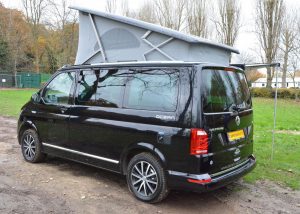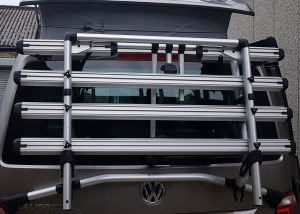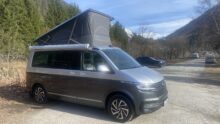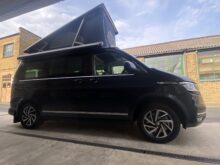Winter Travel in a VW California
Before setting off on a foreign trip during the winter months there are a few things you must research to ensure you are adhering to the particular laws of that country.
If touring there might be several different countries you plan to drive through and each country may have different rules and regulations for different seasons — so it is important to know what is required. A great place to start your research is the AA website; the link below will take you to the page where you can select the country/ies you wish to visit and download a PDF fact sheet for that region.
https://www.theaa.com/motoring_advice/overseas/general_advice.html
From seatbelt law to badge requirements and speed limits, we think the AA has it pretty much covered, and as such this article is more geared towards Volkswagen California owners — however, all campervan, SUV and motorhome owners may still benefit from the information contained here.
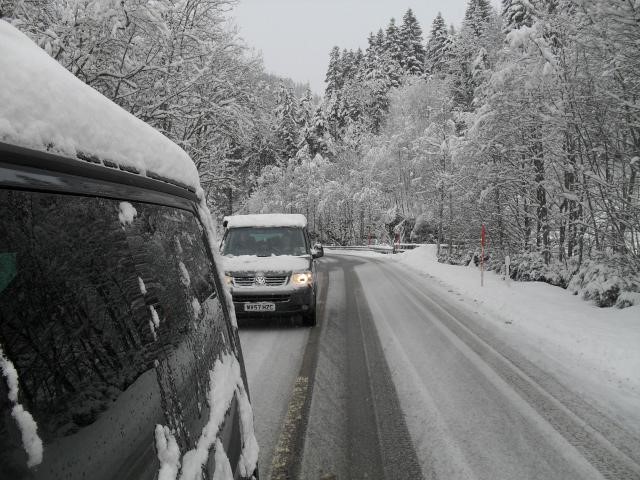 WINTER TYRES
WINTER TYRES
One good piece of advice is to fit winter/snow tyres from November through to February at least, even in if you are in the UK and especially if you are in a remote rural area.
From December 2010 it is has been compulsory in Germany to drive on winter tyres regardless of vehicle nationality so be beware and prepare if you are heading in that direction. If you have the space then it may be worth keeping some winter tyres on sets of steel rims and swap the wheels over in November/December.
Purchasing winter tyres does not need to be an excessively expensive investment, and is one you should consider seriously if you plan to drive your pride and joy in bad weather, let alone to the Alps.
Ask any tyre dealer and they’ll tell you that you don’t need premium tyres to feel the benefit; the sidewall of a winter tyre will be marked with a symbol showing a snowflake or snow-topped mountains, and this is what the German police will be looking for when doing checks!
WHAT’S SO SPECIAL ABOUT WINTER TYRES?
Winter tyres use a rubber compound (high silica content) and tread pattern specifically designed to retain flexibility in low temperatures (below 7°C) and give improved braking/traction performance on snow/ice as well as on wet roads in cold conditions .
If you don’t fit winter tyres then you will need to ensure you have all weather tyres fitted and a decent amount of tread remaining for the countries you are travelling in. Laws in countries can differ on tread depth and at least 3 mm is required in Switzerland and some other countries. Again, check the AA or RAC websites for further information.
https://www.theaa.com/motoring_advice/overseas/snow-chains-winter-tyres.html
Do not forget to check your tyre pressures and if you pack a set of Snow chains practice putting them on. The alloy wheels and tyre sizes on a Volkswagen California can sometimes make getting the right fit difficult (17″ wheels and above). It may be worth noting that specialists such as Campervantastic stock Snow Chains and Snow Socks both for sale and for hire.
 SNOW CHAINS
SNOW CHAINS
Snow chains offer excellent grip but are a bit awkward to fit when you are knee deep in snow and slush, and wrapping them around the wheels can be frustrating when you are cold. similar applies for removing them again, so be prepared to get cold and messy.
That is why you should choose the best chains you can find and look for self-tensioning chain for SUV, crossover, commercial vehicles and motorhomes. A good tip is not to leave it too long before fitting the chains; it is easy to think it is not that bad, only to get stuck later on. Vehicles you see passing without snow chains will probably be using snow tyres – so don’t be fooled into thinking you can get away with it; it could be a costly and even fatal mistake!
BREATHALYSERS FOR FRANCE
If you are travelling through France then you are legally required to carry two NF Certified Breathalysers.
These are not expensive and can be purchased in a twin pack by AlcoSense, these are as used by the French Police. The breathalyser must be compliant with French law and are designed to to alert you at the French Drink Drive limit of 0.5% BAC.
SPEED CAMERA ALERTS IN FRANCE
For those intending to travel through France you should be aware that from the 3rd January 2012 a new law in France made it illegal to be warned by Sat Nav & other devices about the location of speed cameras. However most manufactures like TomTom are introducing a 100% compliant Danger Zones service available in a free download for compatible products. If you don’t switch off your speed camera warnings or upgrade your product to the new Danger Zones then you risk a fine of up to €1,500.
SCREEN WASH
A decent screen wash will protect down to -20°C but always check the label as some places sell screen wash that is absolutely useless in sub zero conditions.
CLEANING
Make sure that you get your campervan cleaned, especially if you return from your winter trip and leave it parked for an extended period of time. The road salt used to clear snow and ice can corrode many different parts of your campervan including your brake disks! This could result in pitting, brake noise and potential disk replacement.
FROST PROTECTION
If you are living in the campervan you can leave the fresh water in the tank as long as you keep the temperature above 0°C.
However it is better to drain the water tank when leaving the campervan uninhabited for any length of time – you also need to drain the waste tank and the residue of water from the sink tap otherwise it can freeze and break.
If you leave any food, drink or water bottles in the van in extreme cold then expect everything to be frozen! If you are parked for a long period it is also recommended to chock the wheels and release the handbrake to prevent the brake pads from freezing to the disks.
Be mindful if using the roll-out sun canopy in the extreme cold as it has been known to freeze, thus making it very difficult to roll back in.
For driving advice in winter from the Institute of Advanced Motorists see the bottom of this post and don’t forget to let us know your experiences and tips.
TIPS FOR SKIERS
Storage can be a real issue when packing winter gear, Bulky clothing, skis, snowboards and boots all need their place. There are a variety of equipment and sleeping options available to make your winter trip a success; such as the Ski and Snowboard soft bags from Thule that can attach to your roof bars and removed folded and stored when not being used.
Also, think about hiring or buying your ski gear here in the UK as it can work out very expensive in some European Locations.
SLEEPING
It is warmer in the lower part of the campervan, so here is a tip if you have small children. Put the campervan in first gear (or park) and chock the wheels – you will then be able to drop the handbrake and rotate the front seats to face each other to create a bed for a toddler. You can also get a hammock that fits across the front cab for older children.
The roof bed can be cold at night in winter so something like the Iso Top roof liner (the Iso Top deflects the heat away from the top air vents and acts as a wind breaker). Other options include the Vanorak or Khyam Kamper Cozi.
These all need to be fitted and removed after closing the roof – however, the advantage of the Iso Top Gore lining is that it can be left fitted when lowering the roof but does not offer as much protection in cold weather. Thermal screens (external or internal) are also recommended which fit over the windscreen and can be used in conjunction with insulation hoods.
HEATING AND INSULATION
 The lower bed area is really toasty – the heating system is amazing and can be used in temps of -18°C and lower; it can be left on through the night without an electrical hook-up and is fuelled by the diesel tank.
The lower bed area is really toasty – the heating system is amazing and can be used in temps of -18°C and lower; it can be left on through the night without an electrical hook-up and is fuelled by the diesel tank.
You may even get few nights or more if you’re careful with the energy and turn off the fridge etc to conserve power. Igniting the heater is a problem when power is low so turning the engine on also charges and can give the batteries a boost.
Check your heating in advance and charge your batteries using the hook up, as your journey alone may not be enough to provide significant charge!
While the heating is the most efficient and practical way to heat your campervan, it is also possible to run a small electric heater when on hook up. However some campsites only offer a 6 amp supply and most heaters are 13 amp so you’ll need to check the current rating of your appliance; a 6 amp supply will be good for a 1KW heater or you could look for one that can be set on half power for when you do not have a 13amps.
If in doubt seek advice from the campsite staff, and for safety sake always keep electric heaters clear from obstructions such as clothing and bags etc.
COOKING
It is unlikely you will have any issues when using the gas burners. However gas can freeze below 0°C so if you find the gas is not flowing try to heat the campervan up first and see if that does the job. The water tank in a California does offer some protection for the gas bottle however you could consider insulating it as well.
Always ensure you have good ventilation when cooking and make sure the burners are turned off when you close the cover!
LOW TEMPERATURE DIESEL
Subject to when you travel, there is also low temperature diesel available in the Alps which might be preferable in sub zero temperatures.
In very cold conditions wax crystals can form in diesel, block the fuel filter and prevent fuel flow. The European quality standard for diesel fuel includes winter requirements specific to each country which ensure that fuel is suited to the local climate.
Fuel capable of operation down to at least -20°C is normal in the popular winter resort destinations.
FINALLY – DRIVE SAFELY
This is what the Institute of Advanced Motorists recommend…
- When driving in snow, get your speed right – not too fast so that you risk losing control, but not so slow that you risk losing momentum when you need it – and brake, steer and accelerate as smoothly as possible.
- Start gently from stationary, avoiding high revs. If you get yourself into a skid the main thing to remember is to take your foot off the pedals and steer.”
- Only use the brake if you cannot steer out of trouble.
- Double or even triple your normal stopping distance from the vehicle in front. Drive so that you do not rely on your brakes to be able to stop – on an icy surface they simply may not do that for you!
- If your vehicle has ABS in very slippery conditions it will not give you the same control it would in others. Do not rely on it.
Top tips for driving in snow and ice
- Plan your journey around busier roads as they are more likely to have been gritted. Avoid using shortcuts on minor roads – they are less likely to be cleared or treated with salt, especially country lanes.
- On motorways stay in the clearest lane where possible, away from slush and ice. Keep within the clear tyre tracks if you can.
- Stay in a lower gear for better control, and if it is slippery move off in second gear, rather than just using first.
- On a downhill slope lower your speed low before you start the descent, and do not let momentum build up – it is much easier to keep low than to try to slow down once things get slippery
- In falling snow use dipped headlights or fog lights to make yourself visible to others (especially pedestrians) – but as conditions improve make sure your fog lights are only on if necessary as they can dazzle other drivers and only recommended for poor visibility.
- If you are following another vehicle at night, using their lights to see the road ahead can cause you to drive dangerously close – always keep well back from other traffic.
